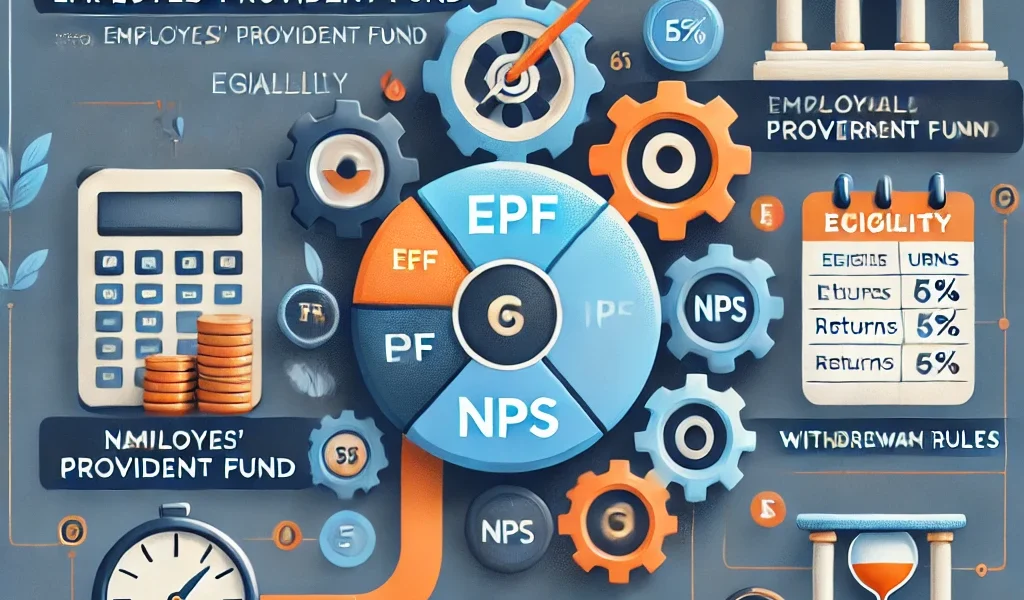Planning for retirement is a crucial financial decision, and selecting the right pension scheme can significantly impact your post-retirement life. In India, three of the most popular pension schemes are the Employees’ Provident Fund (EPF), the National Pension System (NPS), and various other government-backed pension schemes. Each of these schemes has distinct features, benefits, and drawbacks. In this article, we will provide a comprehensive comparison to help you decide which pension scheme is best suited for your needs.
Understanding EPF, NPS, and Other Pension Schemes
1. Employees’ Provident Fund (EPF)
The Employees’ Provident Fund (EPF) is a retirement savings scheme regulated by the Employees’ Provident Fund Organisation (EPFO). It is primarily designed for salaried employees working in the organized sector.
Key Features of EPF:
- Mandatory for organizations with more than 20 employees.
- Both employer and employee contribute 12% of the basic salary and dearness allowance.
- Tax-free interest accumulation and maturity amount.
- Withdrawal allowed after retirement, resignation, or under specific conditions like home loan repayment, medical emergencies, or marriage.
- Provides Employee Pension Scheme (EPS) benefits.
2. National Pension System (NPS)
The National Pension System (NPS) is a government-backed retirement savings scheme that offers market-linked returns and is open to both salaried and self-employed individuals.
Key Features of NPS:
- Open to all Indian citizens aged 18 to 70 years.
- Contributions are invested in equity, corporate bonds, and government securities.
- Two types of accounts: Tier I (restricted withdrawals) and Tier II (flexible withdrawals).
- Partial withdrawal permitted under specific conditions.
- At maturity, 60% of the corpus can be withdrawn tax-free, and 40% must be used to purchase an annuity.
3. Other Pension Schemes
Apart from EPF and NPS, the Indian government offers various pension schemes catering to specific segments of society, such as:
- Atal Pension Yojana (APY): Aimed at unorganized sector workers, provides a fixed pension post-retirement.
- Pradhan Mantri Vaya Vandana Yojana (PMVVY): Designed for senior citizens, offers a guaranteed pension with a fixed interest rate.
- Public Provident Fund (PPF): A long-term savings scheme with tax benefits and secure returns.
Comparison of EPF, NPS, and Other Pension Schemes
| Feature | EPF | NPS | Other Pension Schemes |
|---|---|---|---|
| Eligibility | Salaried employees in the organized sector | Open to all Indian citizens | Specific groups (e.g., senior citizens, unorganized sector workers) |
| Contribution | 12% of basic salary (employee & employer) | Voluntary (minimum Rs. 500/year) | Varies by scheme |
| Returns | Fixed interest rate (set by government) | Market-linked | Fixed or market-linked (depends on scheme) |
| Tax Benefits | EEE (Exempt-Exempt-Exempt) | Partial tax exemption (EEE for 60% corpus) | Varies by scheme |
| Withdrawal Rules | Allowed after retirement or under specific conditions | 60% corpus withdrawal at retirement; 40% annuity purchase | Varies by scheme |
| Best Suited For | Salaried employees | Investors seeking higher returns with flexibility | Low-income individuals, retirees |
Pros and Cons of Each Scheme
1. Employees’ Provident Fund (EPF)
Pros:
- Guaranteed returns and government security.
- Tax-free maturity amount.
- Employer contribution adds to savings.
Cons:
- Limited investment flexibility.
- Premature withdrawals are restricted.
- Not available for self-employed individuals.
2. National Pension System (NPS)
Pros:
- Market-linked returns with multiple investment options.
- Higher potential for wealth creation.
- Flexible contribution and withdrawal options.
Cons:
- Annuity purchase is mandatory for 40% of the corpus.
- Returns are subject to market fluctuations.
3. Other Pension Schemes
Pros:
- Targeted schemes for different demographics.
- Some provide guaranteed pensions.
- Simple and accessible for low-income individuals.
Cons:
- Limited contribution flexibility.
- May not provide high returns.
- Withdrawal restrictions apply.
Which Pension Scheme is Best for You?
Choose EPF If:
- You are a salaried employee in a company with EPF benefits.
- You prefer safe and guaranteed returns.
- You want a tax-free maturity corpus.
Choose NPS If:
- You want higher returns with equity exposure.
- You are looking for retirement income with annuity benefits.
- You need a flexible investment option.
Choose Other Pension Schemes If:
- You belong to the unorganized sector.
- You need a government-backed pension plan with minimal risk.
- You are a senior citizen looking for a fixed pension income.
Conclusion
There is no one-size-fits-all solution when it comes to retirement planning. The best pension scheme depends on your financial goals, risk tolerance, and employment status. EPF is ideal for salaried employees seeking security, NPS is great for individuals looking for long-term wealth accumulation, and other pension schemes cater to specific needs like senior citizens and low-income workers.
To make the best decision, evaluate your financial situation and consider diversifying your retirement portfolio across multiple pension schemes to maximize benefits.



